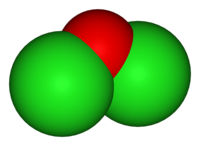
Photo from wikipedia
Quantitative insight into the HCO3--dependent degradation kinetics is critical to improve understanding of the UV processes for the most-cost effective application. In this study, we developed a kinetic model to… Click to show full abstract
Quantitative insight into the HCO3--dependent degradation kinetics is critical to improve understanding of the UV processes for the most-cost effective application. In this study, we developed a kinetic model to precisely predict the kinetics in UV/H2O2 and UV/chlorine processes. The second-order rate constants of HO, Cl, ClO, Cl2-, and CO3- with carbamazepine (CBZ) were fitted as 1.3 × 109, 1.9 × 109, 1.8 × 106, 1.1 × 105, and 4.5 × 106 M-1 s-1, respectively. Based on the model, we investigated the significant impact of bicarbonate (HCO3-) and subsequently generated carbonate radical (CO3-) on CBZ degradation, radical chemistry, and energy requirement of UV/H2O2 and UV/chlorine processes. The presence of HCO3- inhibited CBZ degradation in UV/H2O2 and UV/chlorine processes to different degree. Contributions of HO, Cl, ClO, Cl2-, and CO3- to CBZ degradation in UV/H2O2 and UV/chlorine processes in the absence/presence of HCO3- were investigated. HO and CO3- make comparable contributions to CBZ degradation in UV/H2O2 process in the presence of HCO3- (2 mM), while ClO is always the main contributor at various HCO3- concentration of 0-2 mM. Furthermore, the presence of HCO3- in both processes increased the corresponding EE/O, when CBZ was degraded by an order of magnitude. Overall, HCO3- and CO3- influence the reactions and mechanism of UV/H2O2 and UV/chlorine processes, and have higher impact on UV/H2O2 process.
Journal Title: Chemosphere
Year Published: 2021
Link to full text (if available)
Share on Social Media: Sign Up to like & get
recommendations!